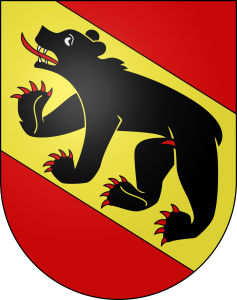
Bears as Mascots
Teddy bears have had their own statues, mourned the loss of the Titanic, and have traveled into space and as well as around the world. They become attached to their human parents. They may speak in an unspoken language, but speak they do, to children of all ages.
Teddy bears are held in high regard by many, and not just by fans and collectors. Just think of how many teddy bears and their grown-up bear cousins are found all around us – in governmental agency’s names, sports teams, and even causes. Let’s look at a just a few non-sporting bear mascots.

California’s mascot is a golden California Grizzly bear, now extinct, chosen because there were so many bears in the state when American settlers first arrived. It adorns both the state flag and seal. In 1846 it represented the short-lived California Republic; a second version was adopted as the state flag in 1911. The California Grizzly was designated the state animal in 1953. The bear is the mascot of the University of California, Berkeley (Golden Bears), the University of California, Los Angeles (Bruins) and the University of California, Riverside (Scottie the Bear, complete with kilt). See mascots/sports teams for the emblems of their mascots.

The heraldic beast of Bern, Switzerland is a black bear. The city’s coat of arms is a black bear on a yellow diagonal band going upward with a red background. The bear has been used as Bern’s mascot, emblem and namesake since the city’s early days. The coat of arms was originally that of a black bear on a white background (the same as Berlin’s), but was changed to its current look in the 13th century. Even today, live bears are kept in its Altstadt in the Bärengraben for tourists to see when they visit the city.

One of the most famous bears in the United States is a mascot for a campaign against forest fires: Smokey Bear. Born in 1944, Smokey has proudly protected the nation’s public and private forests. The slogan “Only YOU Can Prevent Forest Fires” was created by the Ad Council in 1947. This slogan was updated in April 2001 to “Only YOU Can Prevent Wildfires.” Smokey Bear is administered by three entities: The U.S. Forest Service, the National Association of State Foresters, and the Ad Council. “Smokey” is deliberately misspelled to separate it from the more common “smoky.”

And lest we forget, the very first campaign with a teddy bear was that of President Theodore “Teddy” Roosevelt using a teddy bear in his reelection campaign for a second term in office in 1904. Plus, teddy bears have President Roosevelt to thank for their name. Teddy bear maker Morris Mitchtom asked President Roosevelt if he could call his newly made toy by the president’s name and Roosevelt agreed. By 2008 the term teddy bear was also used in Germany by the Steiffs for their stuffed bears.

And then there are the multiple commercial uses for the teddy bear—the candied Gummy Bears and Haribo bears, and fabric softener’s Snuggle Bear to name a few.
So with all these uses for the teddy bear, in addition to them being our loving companions, it’s unlikely we’ll run out of teddy bears to talk about any time soon.
